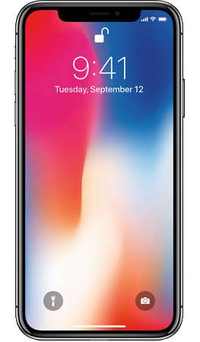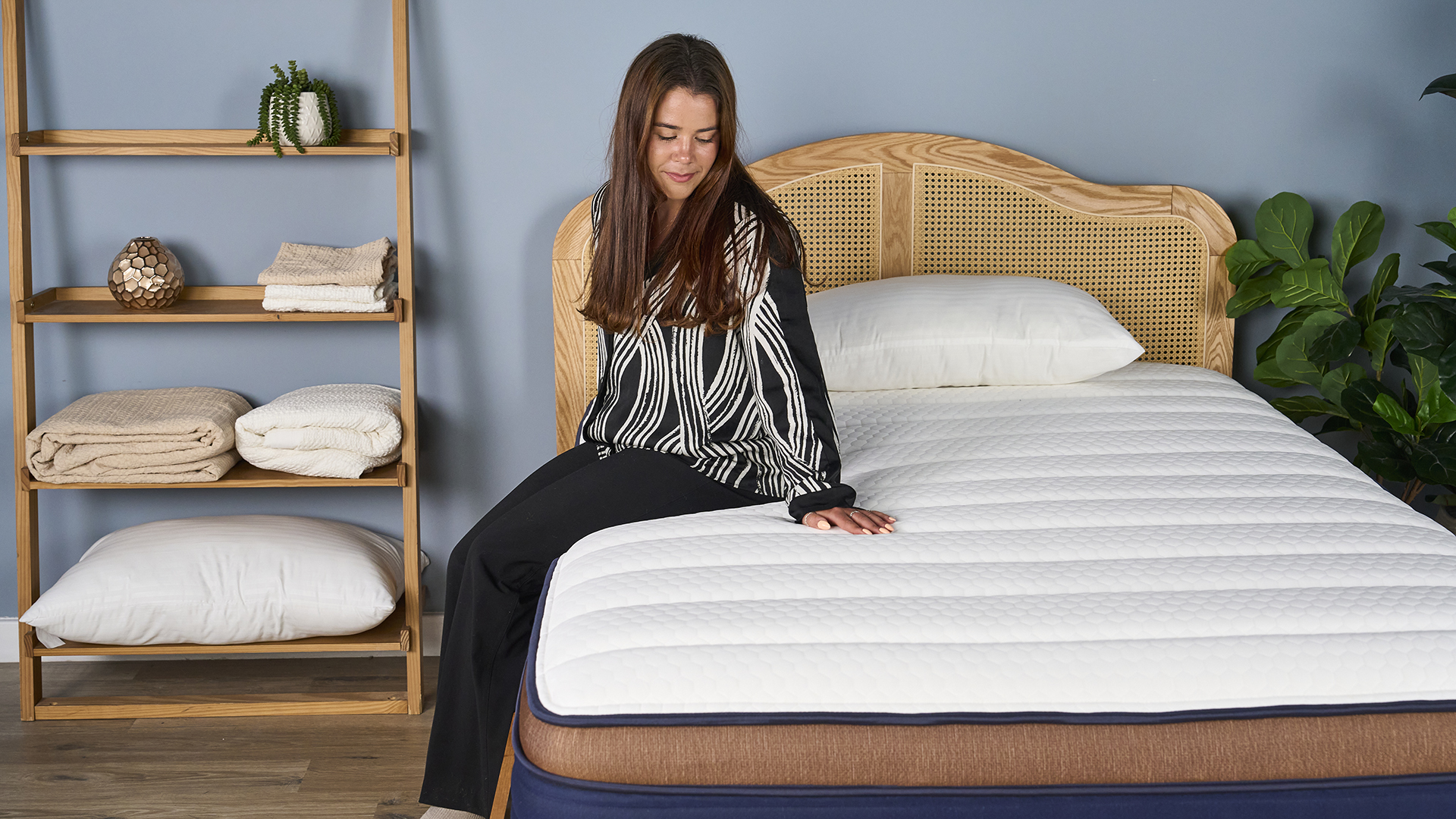iPhone X vs. Galaxy Note 8: Which Big-Screen Phone Wins?
Here's how Apple's 10th-anniversary flagship measures up to Samsung's powerful Galaxy Note 8.
Other smartphone makers might object, but these days, the mobile landscape feels like an ongoing battleground between Apple and Samsung. That's particularly the case when one of these companies rolls out a new phone.
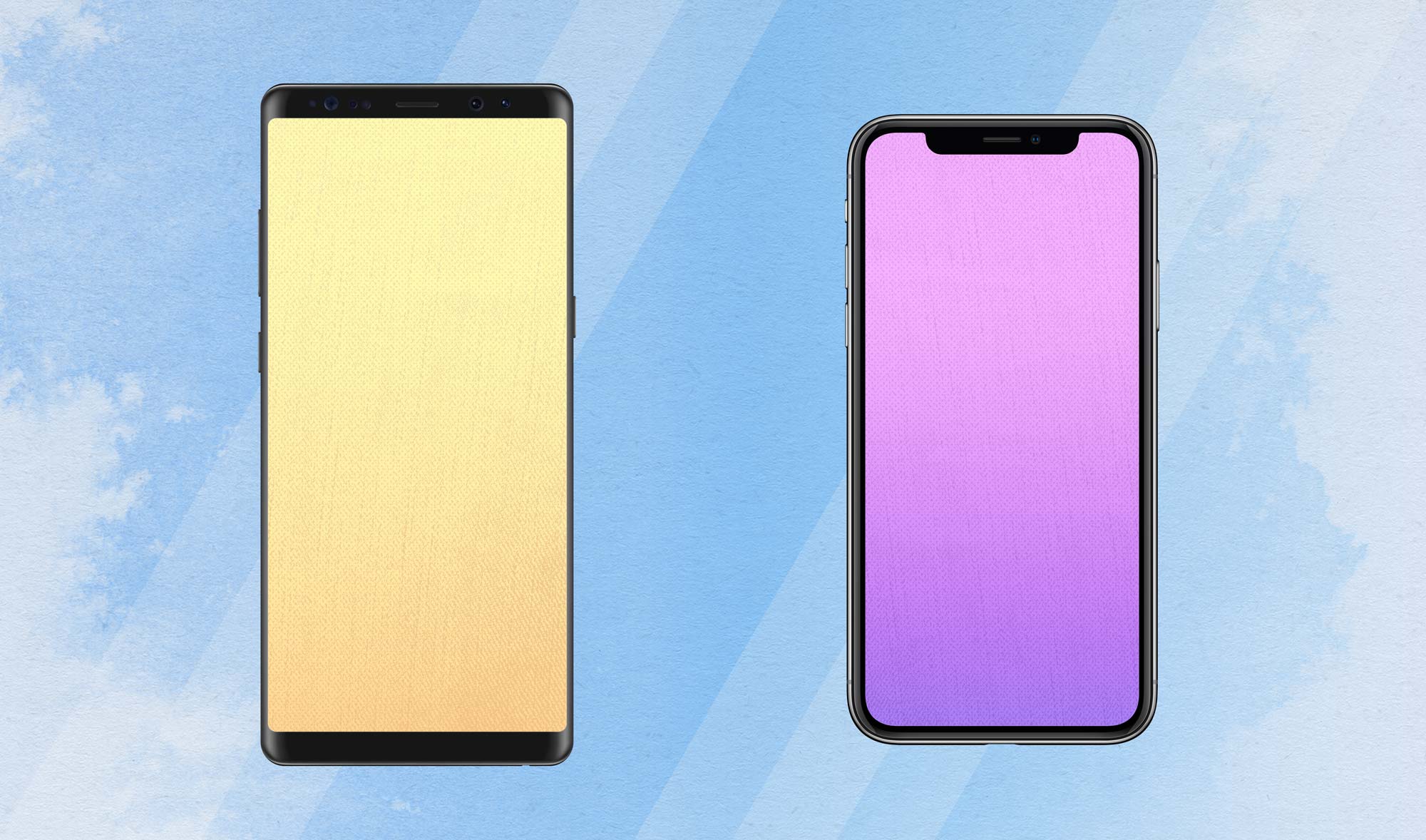
And that's exactly what's happening now, as the iPhone X arrives. Apple's latest offering delivers an edge-to-edge OLED display that practically does away with bezels, a new depth-sensing front camera for Face ID and a pretty hefty $999 price tag.
The $950 Galaxy Note 8 also offers an edge-to-edge OLED screen, both face and iris recognition, and a unique S Pen for taking notes, drawing and more.
Now that we've had a chance to review the iPhone X, it's time to take a closer look at how Apple's latest flagship measures up to Samsung's supersized phone. For all that the iPhone X and Note 8 have in common — and they're pretty evenly matched as you'll see below — these devices differ in significant ways that will determine exactly who finds either phone appealing.
Update Nov 4: We've updated this face-off with results from our iPhone X battery, camera and performance testing.
iPhone X vs. Galaxy Note 8: Specs Compared
| Row 0 - Cell 0 | iPhone X | Galaxy Note 8 |
| List Price | $999 | $950 |
| OS | iOS 11 | Android 7.1.1 |
| Screen Size (Resolution) | 5.8-inch OLED (2436 x 1125) | 6.3-inch AMOLED (2960 x 1440) |
| CPU | A11 Bionic | Snapdragon 835 |
| RAM | 3GB (Estimated) | 6GB |
| Storage | 64GB, 256GB | 64GB |
| microSD | No | Yes |
| Water Resistance | IP67 | IP68 |
| Rear Camera | 12-MP wide angle (f/1.8); 12-MP telephoto (f/2.4) | 12-MP wide angle (f/1.7)12-MP telephoto (f/2.4) |
| Front Camera | 7-MP (f/2.2) | 8-MP (f/1.7) |
| Headphone Jack | No | Yes |
| Battery Life | 10:49 | 11:11 |
| Size | 5.7 x 2.8 x 0.3 inches | 6.4 x 2.9 x 0.34 |
| Weight | 6.14 ounces | 6.9 ounces |
Design
The design trend Samsung started with the Galaxy S8 phones earlier this year continues with the Note 8. Samsung's phablet is practically all-screen up front, with the phone's display wrapping around the Note 8's edges and the top and bottom bezels all but gone. If there's a flaw to this look, it's that it's forced Samsung to move the Note 8's fingerprint sensor to the back of the phone, a design decision made worse when Samsung placed that sensor right next to the Note 8's rear cameras.
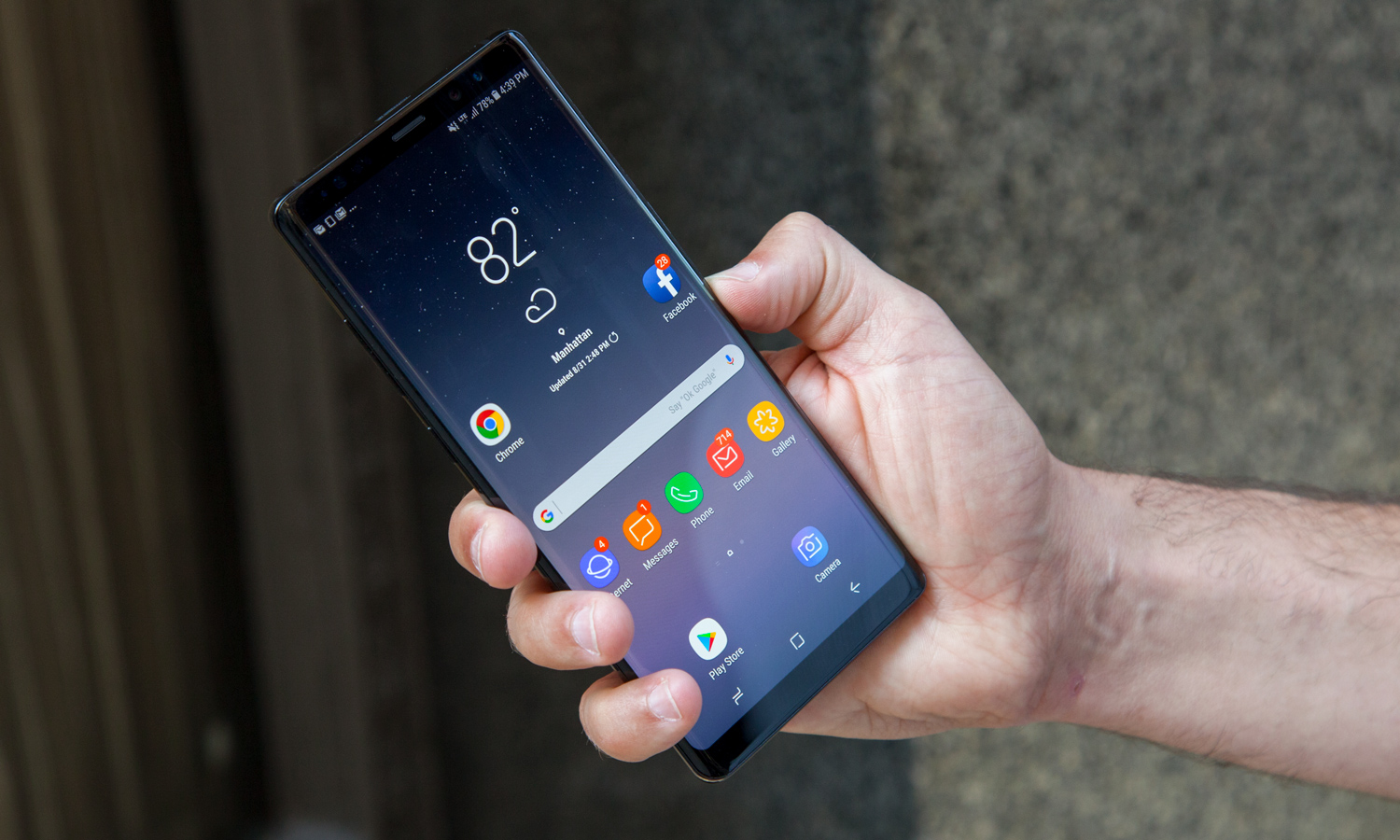
The iPhone X has a similar look, with one noticeable difference. Like the Note 8, the iPhone X's screen stretches from top to bottom, though it doesn't wrap around the sides of the phone. The biggest departure for the iPhone X, though, is the notch that houses the front-facing camera and related sensors: it dips down into the iPhone X's display. The notch has already divided opinion, and that's before anyone's had the chance to watch videos and play games on the screen.
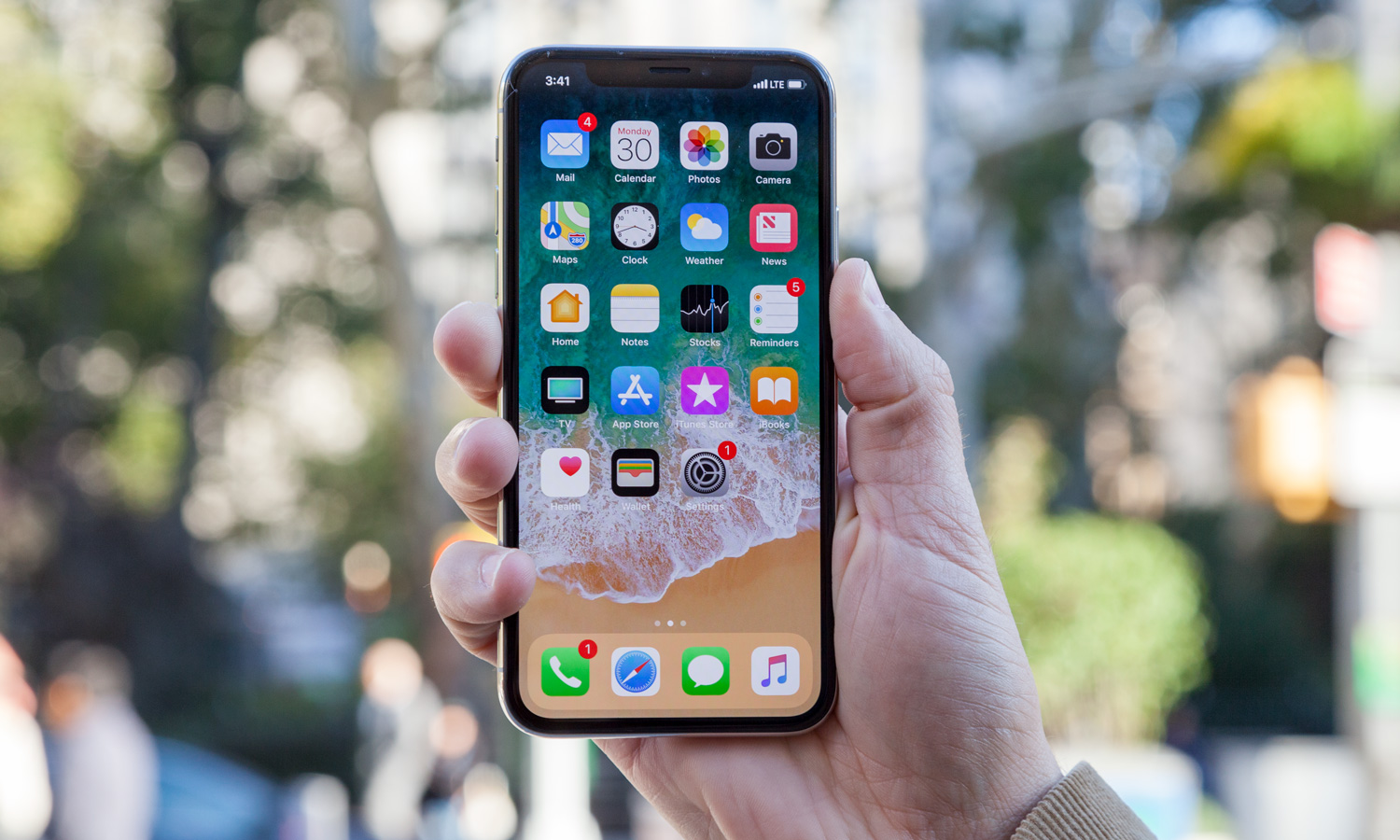
Regarding size, the Note 8 is noticeably taller than the iPhone X — 6.4 inches to 5.7 inches — with the width and thickness about the same. That's entirely the result of the Note 8's larger 6.3-inch display. At 6.9 ounces, the Note 8 outweighs the 6.14-ounce iPhone X, too.
Winner: Note 8. We'll take more screen space over a compact form, and the curved edge-to-edge look of the Infinity Display is hard to beat.
Display
Samsung has enjoyed a big advantage over Apple for years because its phones used OLED panels. Apple has turned to LCD screens and continues to use them with its new iPhone 8 and 8 Plus models.
But it looks like Apple finally wants to close the display gap with Samsung, by giving the iPhone X an OLED screen. The supplier of that OLED panel? Samsung itself (reportedly). Look for the iPhone X to have better contrast and blacker blacks than you've seen before on an iPhone.
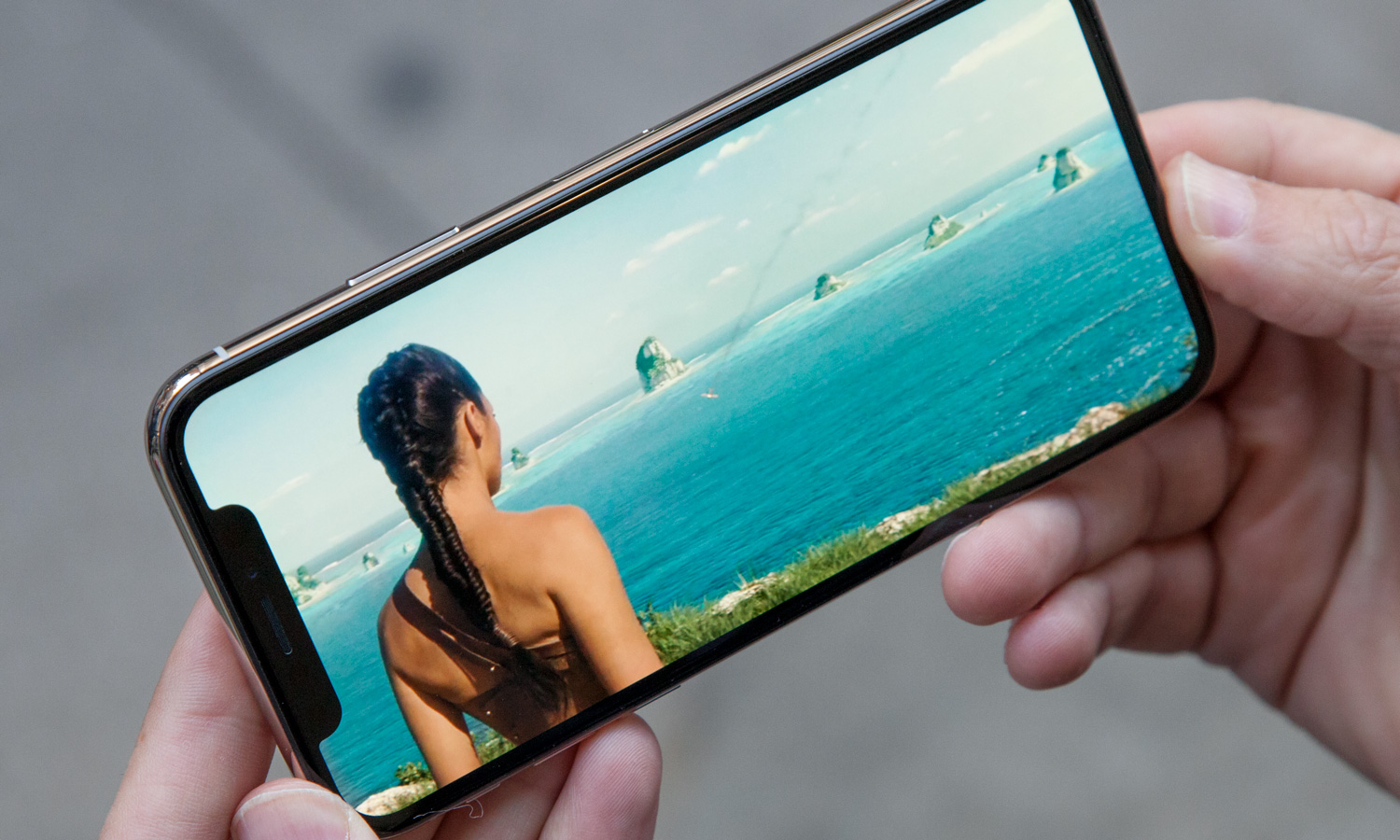
The iPhone X starts at something of a disadvantage, with a 2436 x 1125 resolution at 458 pixels per inch (ppi). That's the sharpest resolution ever for an iPhone, but it still trails the 2960 x 1440 resolution on the Note 8. And with 521 ppi, Samsung is packing in more pixels per inch on its display.
Still, when we stacked the phones side by side, we were impressed with Apple's take on OLED. Colors look less saturated on the iPhone X's screen. Apple's True Tone feature lets the iPhone X adjust white balance to match ambient lighting. And the iPhone X minimizes a problem common to OLED panels by maintaining brightness even when you view the display from off-center angles.
Winner: iPhone X. While not as sharp as the Note 8's screen, the iPhone does a better job with contrast, color and brightness.
Cameras
Samsung clearly felt the heat from the iPhone 7 Plus and its dual rear cameras. After Apple won plaudits for adding two cameras to the back of its 2016, Samsung followed suit with the Note 8. And those two lenses — a 12-megapixel wide-angle camera with an f/1.7 aperture accompanied by a 12-MP telephoto lens with an f/2.4 aperture — produce some stellar shots.
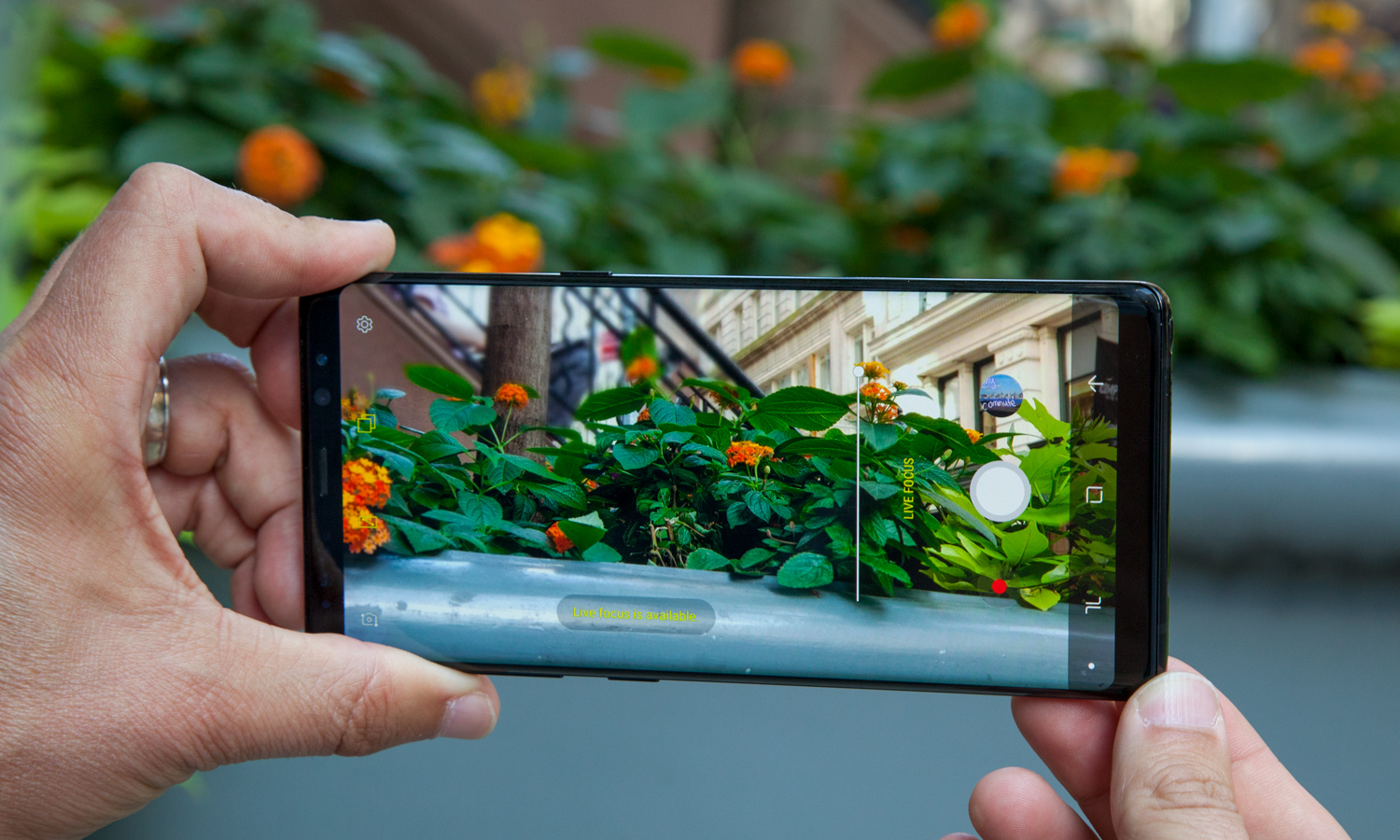
When we tested the Note 8, we particularly liked the Dual Capture feature, which takes simultaneous close-up and wide-angle shots. And of course, you can use the dual cameras on the back of the Note 8 to capture what Samsung calls a Live Focus mode, which lets you blur the background of a photo similar to Apple's Portrait mode feature. The difference with the Note 8 is that you can adjust the focus before and after the shot, which the iPhone X can't do.
Both rear cameras on the Note 8 feature optical-image stabilization, something the iPhone 7 Plus and 8 Plus can't claim. The iPhone X can, however, which should make it a formidable competitor to the Note 8. Apple's new phone also has a pair of 12-MP lenses, one with an f/1.8 aperture, the other with an f/2.4 aperture. As with the iPhone 8 Plus, the iPhone X offers a beefed-up Portrait mode with new lighting effects you can adjust before and after you take the shot.
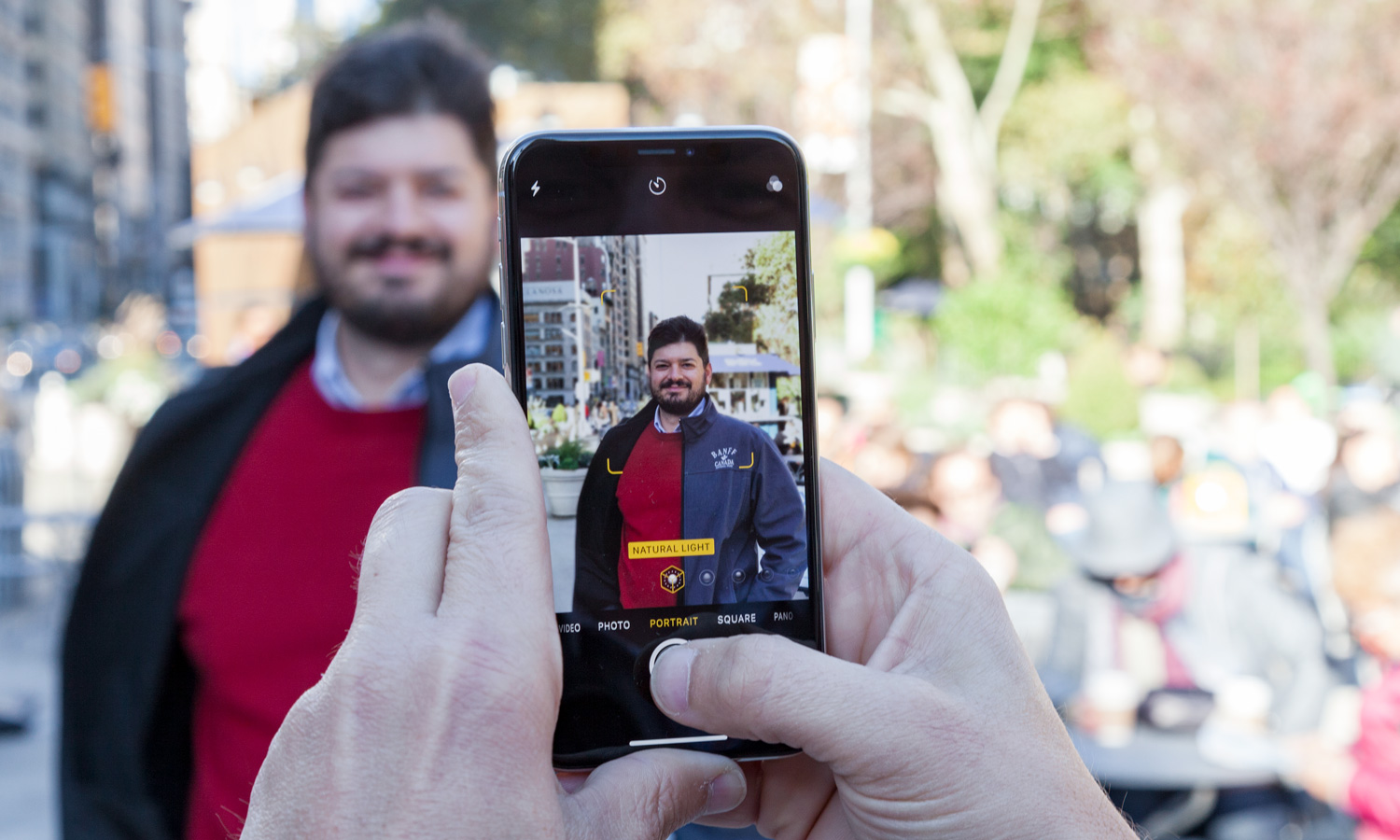
The front camera on the iPhone X is more powerful, too. It's a 7-MP shooter that's also capable of pulling off Portrait mode shots, and its various sensors support the iPhone X's Face ID unlocking feature.
We'll put together a more comprehensive photo shootout between the Note 8 and iPhone X, similar to the one we did for the iPhone 8 Plus vs. Samsung's phablet. But after taking similar shots with both phones, we give the iPhone X the edge over the Note 8.
These dueling shots of the Flatiron Building in New York show off the iPhone X's prowess at capturing details. The contrail stands out more in the sky, which is a brighter shade of blue. Meanwhile, the Note 8 struggled with the sun, leading to some over-exposure in the shot.
Both cameras did a solid job capturing these pinkish-purple flowers, though again, the nod goes to the iPhone X. While the Note 8 certainly did a good job handling the colors, the iPhone X offers more depth and contrast in the flowers. The background blur also looks more consistent to my eye.
Performance
With the iPhone X now in hand, we can confirm what we first saw when the A11 Bionic-powered iPhone 8 Plus blew away Android phones: the iPhone X is another powerhouse performer.
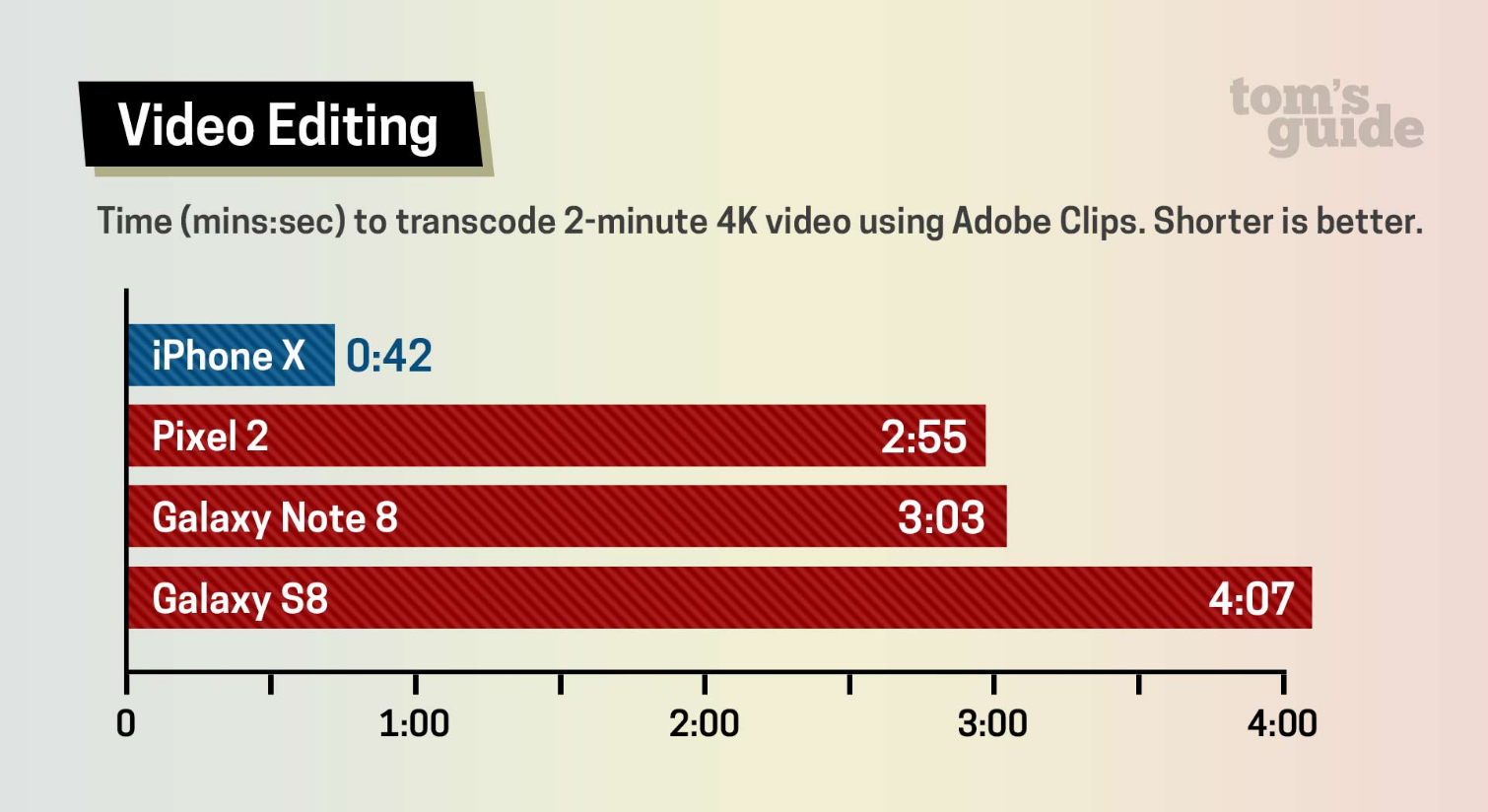
Our video editing test, in which we have phones transcode a 2-minute 4K video, is a perfect illustration of the A11 Bionic's power. The iPhone X completes the task in 42 seconds. The Note 8, which features a Snapdragon 835 mobile processor, needs 3 minutes to get the job done.
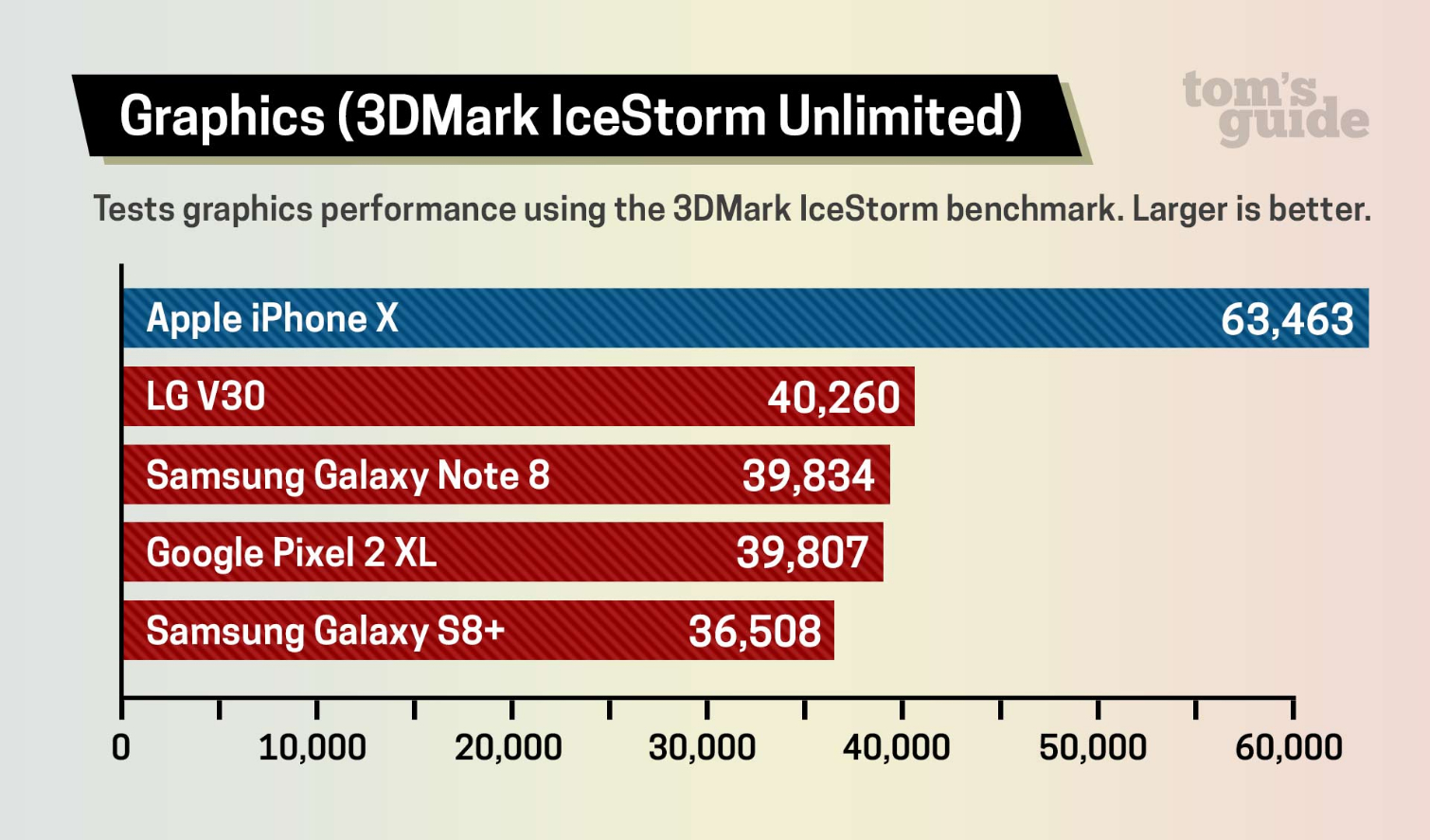
There's a similar performance gap in synthetic benchmarks too. Running Geekbench 4, which measures overall performance, the iPhone X turned in a score of 10,357. The Note 8 performs the best of any Android phone we've tested with Geekbench 4, but its 6,564 score is still well behind what the iPhone X can do. The same goes with the 3DMark IceStorm Unlimited test of graphics prowess, where the iPhone X improved on the Note 8's score by 59 percent.
Winner: iPhone X. And it's not at all close.
Battery Life
You'll get good battery life from both the Note 8 and iPhone X, with both devices handily outlasting the average smartphone on our Tom's Guide Battery Test (continuous web surfing over LTE). But you'll get better battery life with Samsung's phone.
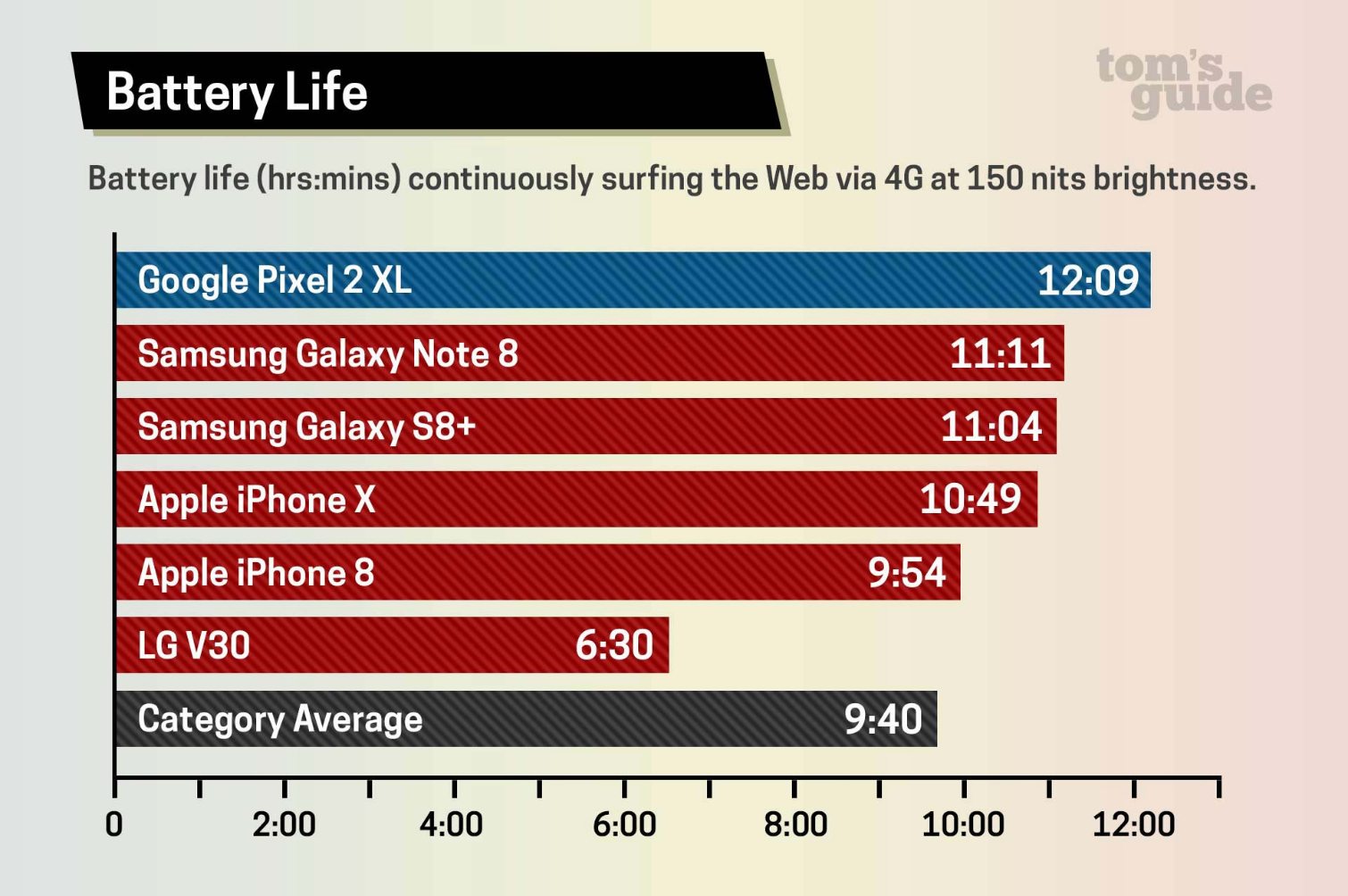
The Note 8 lasted 11 hours and 11 minutes, placing it on the list of longest-lasting smartphones we've tested. The iPhone X just missed landing on that list, with a time of 10:49. In fact, the iPhone X isn't even Apple's longest-lasting phone. That honor goes to the iPhone 8 Plus, whose 11:16 time is just ahead of the Note 8's.
Both the iPhone X and Note 8 charge wirelessly, and each phone supports fast charging, too. However, fast wired charging with the iPhone X requires purchasing a separate USB-C power adapter and a USB-C to Lightning cable.
MORE: Tested: Fast Charge Your iPhone 8 or iPhone X for Half the Cost
Special Features
The S Pen has long been one of the best things about the Galaxy Note series, and that continues with the Note 8. Samsung has enhanced the already powerful stylus with new capabilities, like being able to translate entire passages of text, or turning doodles into animated GIFs you can easily share with others. A feature that let you jot down notes without unlocking the phone while using the S Pen has been expanded to support 100 pages worth of notes.
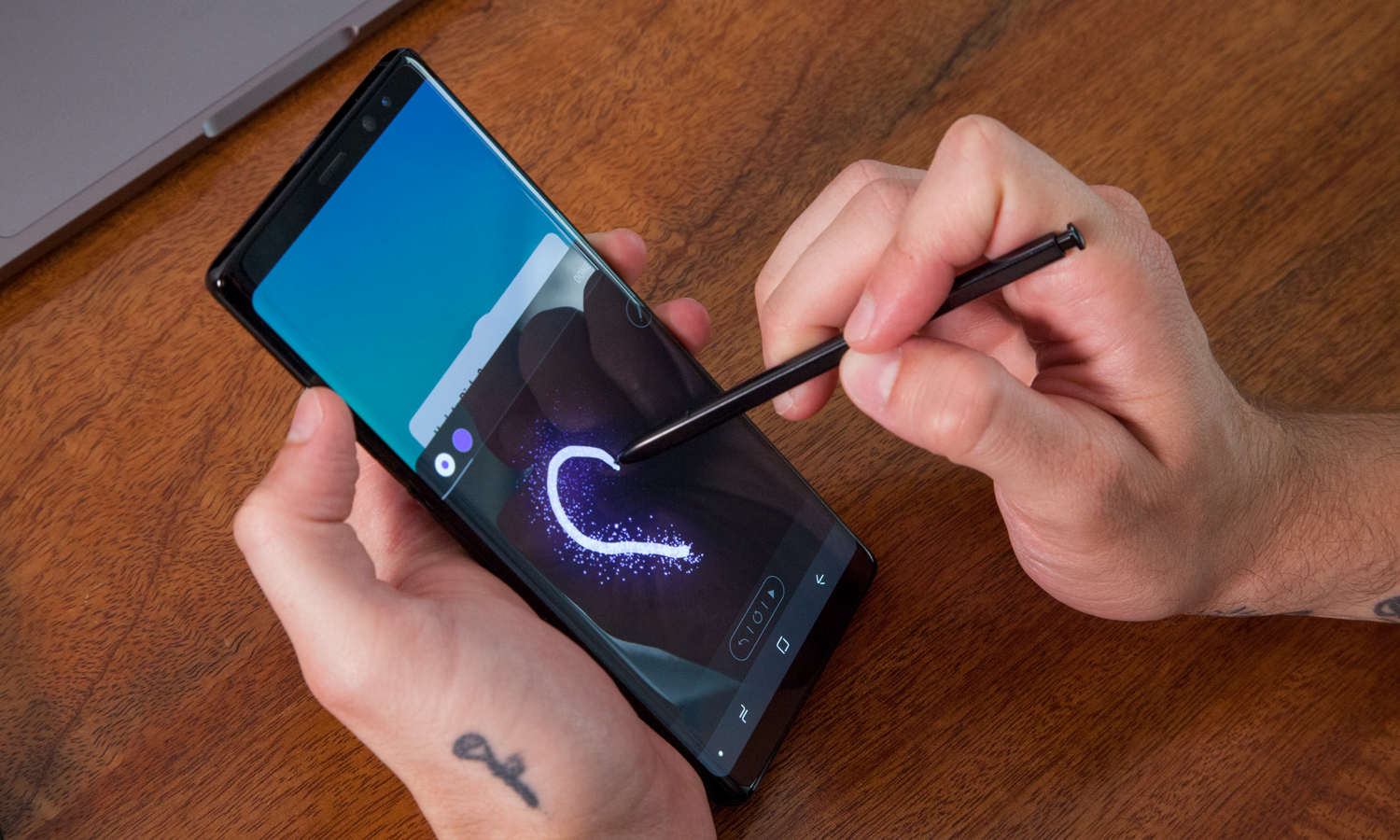
The Note 8 boasts other charms, too. It's got the built-in Bixby assistant, for controlling functions of the phone with your voice, and a App Pair feature for automatically launching two apps side by side. Add the Dex Dock accessory, and you can turn your Note 8 into a mobile PC.
Apple counters with Face ID for the iPhone X, allowing you to unlock your phone and confirm Apple Pay payments with just a glance of your face. We're interested to see how that feature improves upon the Touch ID that's been in previous phones since the iPhone 5s.
That TrueDepth camera on the front of the iPhone X does more than shoot selfies and unlock your phone. You can also use it to turn your face into an animated emoji in Messages — Apple's dubbed this "animojis" — that even mimics your expressions.
Winner: Note 8, by the length of the S Pen.
Pricing and Availability
Both phones are going to cost you. The Note 8 is the less expensive option, though "less expensive" is relative when you're talking about a $950 phone. The iPhone X starts at $999 for the 64GB version, and you'll pay $1,149 if you want 256GB of storage.
The $50 price difference isn't much and becomes even less stark if you pay for the phone in monthly installments. The difference is essentially $1.66 or so per month at AT&T, Sprint and Verizon when you spread payments out over time; at T-Mobile, you simply have to pay an extra $49.99 up front for the iPhone X, with monthly payments costing the same.
iPhone X vs. Galaxy Note 8 Pricing
| Payment Option | iPhone X | Galaxy Note 8 | Price Difference |
| Full Price | $ $999 | $ $950 | $49 |
| AT&T (Monthly) | $ $33.34 | $ $31.67 | $1.67 per month |
| Sprint (Monthly) | $41.67 | $40 | $1.67 per month |
| T-Mobile (Monthly) | $30 ($279.99 down) | $30 ($230 down) | $49.99 down |
| Verizon (Monthly) | $ $41.66 | $ $40 | $1.66 per month |
You can buy an unlocked version of the Note 8 through Samsung, with the phone also available through AT&T, Sprint, T-Mobile, Verizon and US Cellular. At present, the iPhone X is only available for preorder tied to the four major carriers and Xfinity Mobile; an unlocked version could become available after the phone arrives in stores on Nov. 3, but we'll have to wait and see.
Winner: Draw, though at the moment the Note 8 is probably easier to get your hands on more quickly.
Bottom Line
The iPhone X-vs.-Galaxy Note 8 showdown is about as close as you can get between two top-line phones — so close in fact, that the devices split things right down the middle.
| Phone | iPhone X | Galaxy Note 8 |
| Design | Row 1 - Cell 1 | X |
| Display | X | Row 2 - Cell 2 |
| Camera | X | Row 3 - Cell 2 |
| Performance | X | Row 4 - Cell 2 |
| Battery | Row 5 - Cell 1 | X |
| Special Features | Row 6 - Cell 1 | X |
| Price | X | X |
| Total | 4 | 4 |
The Note 8 gets the nod for design, better battery life and special features like the S Pen. The iPhone enjoys slight edges for display and camera and a big boost for performance. The pricing on both phones is close enough to where that's pretty much a push, at least until carriers start offering more discounts and incentives.
So which phone is best for you? As always, it depends on what you're looking for in a device. If you want a device with ample screen real estate for multitasking, the Note 8's expansive 6.3-inch screen along with the App Pair feature and S Pen will help you get more things don on your phone. If your phone doubles as your primary camera and you run a lot of processor-intensive apps, the iPhone X is the better pick. You can expect all-day battery life from both phones, but the Note 8 lasts just a bit longer and supports fast-charging without any add-ons.
Both phones have won Editor's Choice honors from us, so you're going to get a top-of-the-line device whether you opt for the iPhone X or Note 8. Just make sure the phone you do pick is best suited for the things you really count on in a mobile device, and you should be set.
Credit: Tom's Guide/Apple
Sign up to get the BEST of Tom's Guide direct to your inbox.
Get instant access to breaking news, the hottest reviews, great deals and helpful tips.
Philip Michaels is a Managing Editor at Tom's Guide. He's been covering personal technology since 1999 and was in the building when Steve Jobs showed off the iPhone for the first time. He's been evaluating smartphones since that first iPhone debuted in 2007, and he's been following phone carriers and smartphone plans since 2015. He has strong opinions about Apple, the Oakland Athletics, old movies and proper butchery techniques. Follow him at @PhilipMichaels.
-
jbblock1 The Note 8 is the most clever customizable intuitive well-crafted thing I have ever owned. I use it as full computer through the Dex Station. It even supports my network. The spen is not to be trivialized either, It creates a mouse like experience.Reply -
Anthony Jatero After waiting for a few years for Note replacement as an artist I have to say they are still unmatched as the S Pen is not just a stylus the levels of pressure sensitivity allow me much more than simple software added size and angle adjustment. I am also a content Junkie when I'm not using Microsoft Office Word and Excel for work (Netflix instagram)etc and absolutely love my Note8 screen and could not for the life of me get used to or force myself to try to ignore what amounts to a thumb perpetually stuck to one side of a phone which is what the iPhone x looks like to me. And if you look for more than one second at the iPhone x it definitely has Basil's all around the entire phone which makes me wonder why they didn't just have a smaller piece of glass as they're not using all of it? The notch and rounded edges eat into the true screen real estate so what is the actual screen real estate if you want to see all of your content like a movie without chopping off all the edges not 5.8 How is that measured?Reply
I am pretty sure by now that most people that actually use phones ignore the benchmarks that come up each year showing devices 20 or 30 times faster than other phones when in reality and actual use there is no discernible difference between any of them since 2015 unless you like swiping between your notification panel icons back and forth all day games run as fast as they're going to run photos are taken look beautiful and Internet web pages load as fast as your provider will allow.
The iPhone x does look pretty and I am sure that people will love it as if you are a fan of the Apple ecosystem you don't have much choice between the X and the 8th which is essentially a seven or 6. This phone will surely be successful but I am more than happy with my Note8 on every level. -
takashilater Reply20327114 said:After waiting for a few years for Note replacement as an artist I have to say they are still unmatched
How do you find the spen compares to the Apple Pencil on an iPad Pro? Is it as good? I've found the 120hz refresh rate on the iPad Pro to be the major game changer for any decent art. Is the SPen just good in a pinch or have you compared to use on a tablet?
I ask because I've always found even the large phones to be annoying to do anything but the most trivial of work. -
takiB Obvious - Note 8 is superior productive device.Reply
- Performance on everyday tasks is not measured by processor speed -now many edit videos on a mobile that has < 4K resolution? A youtube test showed Note 8 is smoother.
Note 8 is still 7.1, wait for Android 8 & further optimisation. Exynos is faster, why didn't you use that? Tests where 6GB ram makes difference? (Python code, VR...)
-Price & availability, draw - Really? Note cheaper, extra SD up to 400GB (replaceable) at fraction $, IphoneX waiting increasing to months...
Note 8 is in a different category. iphone X ~ Galaxy S8 -
takiB Takashilater. You can read...Reply
Samsung’s Staedtler stylus is roughly 5,000 times more awesome than the Apple Pencil
https://www.theverge.com/circuitbreaker/2017/2/27/14748442/samsung-staedtler-noris-pencil-stylus-mwc-2017
Apple Pencil Vs. Samsung S Pen: Price & Precision http://www.investopedia.com/news/apple-pencil-vs-samsung-s-pen-price-precision/
http://time.com/4708671/samsung-galaxy-tab-s3-release-review-ipad/ -
brucewayneyip I have been a Note 1 to 7 owner since coming from the iPhone 4S. I second the above comments from other Note users and I'm perplexed how no reviewer ever mentions Android Home Screen widgets. With 6 gb my Note 8 hoome screens are incredible dynamic screens for all my trading apps, news, Twitter, coursera, gtasks, email, sms, floating books from Google play books And floating post it notes per category from Lecture Notes app etc. I seldom have to select an app over and over again as all my dynamic data is visible on 7 customized home screens.Reply -
taurus5569 So after going into the Apple store to check out the new Emoji $2000 iPhone I realised when I got my Samsung Galaxy Note 8 was definitely the right choice whilst saving $400 in the process. This is coming from an iPhone userReply -
mdr21797 The display on the iPhone x is better? Are you serious? How can an OLED be better than a Super AMOLED screen? How naive can iPhone users be? I went to an apple store and placed my note 8 side by side with an iPhone X. There was no comparison. The note 8 display is by far the most beautiful display on a smartphone. Period.Reply -
monchwow Only Samsung users need to justify why their device is better. Most iphone users just seem unbothered.Reply
For Android, I prefer the Pixel line. All these features Samsung crams into their device doesn’t change the fact that after a year, Galaxy devices run all slow and laggy etc. Never again. -
ifIwasarichman Quote - "The Note 8 is the less expensive option, though "less expensive" is relative when you're talking about a $950 phone."Reply
( Please Note - $950 is US dollars and I am quoting Australian below and US$950 = A$1250 and the prices are quoted to buy the phones outright and unlocked from a shop, not as part of a plan)
The Note 8 is significantly cheaper now in Australia, especially when compared to the iphone X.
As always, Apple has decided to place a huge premium on the price of the phone here and this has a huge impact on the final verdict.
OVERALL WINNER -- Samsung Note 8
With the iphone X costing A$1829 (US$1390) for the 128GB or A$1579 (US$1207) for the 64GB.
Whereas the Note 8 can be bought for as chea64GB p as A$993 (US$759).
That is over 50% more for the new iphone 64GB.
And getting close to double the price for the 128GB iphone
I definitely know which one I prefer,
Plus I just happen to have a spare 256GB micro SD card lying around, pity one will not accept a micro SD.
